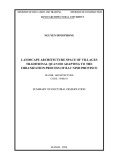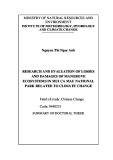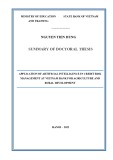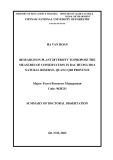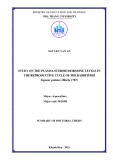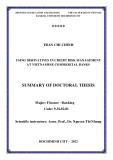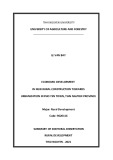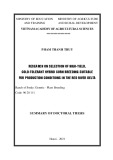MINISTRY OF EDUCATION AND TRAINING MINISTRY OF HOME AFFAIRS NATIONAL ACADEMY OF PUBLIC ADMINISTRATION ------------------------ PHAM DUC TOAN COMPETENCY-BASED CIVIL SERVANT MANAGEMENT IN STATE ADMINISTRATIVE AGENCIES TO MEET THE ADMINISTRATIVE REFORM REQUIREMENTS IN VIETNAM
Major: Public Management Code: 9 34 04 03
SUMMARY OF DOCTORAL THESIS IN PUBLIC MANAGEMENT
Science instructors:
1. Assoc. Prof. Dr. Nguyen Thi Hong Hai 2. Assoc. Prof. Dr. Nguyen Ba Chien
HANOI - 2020
INTRODUCTION
1. Urgency of research issues Performance efficiency and effectiveness of public administrative agencies depends much on work performance of each civil servant. They are people who directly deploy the Party’s guidelines, policies, the State’s laws into life; they are also managers, planners for the sustainable development of the State. However, their performance does not meet the increasing demand of the whole society.
In the world, competency-based human resource management is the approach showing the responsiveness to changes in organization and culture that are taking place in many developed countries, it is initiated in UK and spreading to OECD countries. It is always associated with defining competencies, developing a competency framework and using it as a basis for recruitment, selection, training and development, compensation and other aspects of human resource management. Competency and competency framework can be applied in the different aspects of human resource management. A competency-based human resource management system focuses on identifying the competencies needed to achieve effective service performance.
On 13 November 2008, the 4th session of the XII National Assembly passed the Law on Public Officials and Civil servant to replace the Ordinance on Public Officials and Civil Servants, effective January 1, 2010, creating a legal basis and premise for renewal and improving the civil servant management in Vietnam in association with promoting the capacity of the contingent of civil servants. In Resolution No. 30c/2011/NQ-CP dated November 8, 2011 of the Government on the promulgation of the overall program of public administrative reform (PAR) in the 2011-2020 period, the reform is to "complete a system of socialist-oriented market economy institutions to liberate production forces, mobilize and effectively use all resources for the country's development ...
Administrative reforms in the next 10 years will focus on institutional reform, building and improving the quality of cadres and civil servants... The key point may be we have to change and accesse properly the contents of activities related to improving capability of officials and civil servants. Therefore, competency management and development to form high-quality civil servants serving the process of reform and inetrnational integration is an
1
urgent requirement in our current context.
The above interpretations and justifications show that in-depth research on civil servant competency and competency-based management in our country is essential to supplement more theoretical systems of civil servant competency development and applied research in State administrative agencies in Vietnam. Therefore, I choose the topic "Competency based civil servant management in State administrative agencies to meet the administrative reform requirements in Vietnam".
2. Research questions and research hypotheses 2.1. Research questions
- How does competency of civil servants affect the efficiency and
effectiveness of State administrative agencies?
- To meet the current requirements of public administrative reform in
Vietnam, what competencies should civil servants be equipped with?
- Why should civil servants be managed based on competency in State
administrative agencies in Vietnam?
- What are the prerequisites for applying competency-based civil servant
management in Vietnam?
- In order to be able to apply competency-based civil servant management in State administrative agencies in Vietnam, what should the responsible authorities do? 2.2. Research hypothesis Để nâng cao chất lượng nguồn nhân lực và tạo động lực thực thi công vụ trong cơ quan hành chính nhà nước đáp ứng yêu cầu cải cách hành chính thì cần phải quản lý công chức theo năng lực.
Nhằm áp dụng quản lý công chức theo năng lực trong cơ quan hành chính nhà nước cần bảo đảm triển khai đồng bộ việc tuyển dụng, sử dụng, đãi ngộ công chức theo năng lực trên cơ sở một khung năng lực phù hợp với yêu cầu của các vị trí việc làm.
To improve the quality of human resources and motivate the performance of public duties in State administrative agencies, meeting the requirements of administrative reform, it is necessary to manage civil servants based on competency.
In order to apply competency-based civil servant management in State administrative agencies, it is necessary to ensure the uniform deployment of recruitment, selection, employment and remuneration of civil servants
2
3.2. Research Scope Regarding the contents, the
according to their competence on the basis of a competency framework appropriate to requirements of jobs and positions. 3. Object and Scope of the Thesis 3.1. Research Object Research object of the thesis is competency-based civil servant management in State administrative agencies, meeting administrative reform requirements. thesis focuses on researching the competency-based civil servant management system in the following aspects: competency-based civil servant recruitment and selection; competency-based civil servant employment; competency-based civil servant training and retraining; competency-based civil servant assessment; competency-based pay and remuneration;
Regarding time duration, the thesis studies legal documents and statistical data since the Law on Cadres and Civil Servants 2008 was enacted. 4. The research purpose and tasks of the thesis
4.1. The research Purpose Trên cơ sở nghiên cứu về quản lý nguồn nhân lực theo năng lực và phân tích, đánh giá thực trạng quản lý công chức, luận án đề xuất quan điểm và giải nhằm pháp quản lý công chức theo năng lực đáp ứng yêu cầu cải cách hành chính ở Việt Nam.
Based on studying competency-based human resource management and analyzing and assessing the status of civil servant management, the thesis proposes views and solutions for competency-based civil servant management based on competency to meet the requirements of the administrative refrom in Vietnam.
4.2. The research tasks - Conducting overall domestic and foreign research works to identify
new content and contributions that are of theoretical and practical values;
- Researching and generalizing the
theoretical framework of competency-based civil servant management, taking it as a basis for assessing the current status of civil servant management in Vietnam, including recruitment, employment and remuneration of civil servants;
- Analyzing and interpreting actual situation to indicate limitations and causes of the limitations thereby confirming the necessity of competency-
3
based civil servant management, satisfying the requirements of administrative reform in our country;
- Suggesting a system of solutions and roadmaps to gradually apply to current
in response competency-based civil servant management, administrative reform and international integration requirements. 5. Research methodology and research methods
5.1. Research methodology The thesis is conducted based on the methodology of Marxism-Leninism (dialectical materialism, historical materialism and dialectical materialism). The research contents are systematically interpreted and justified to ensure the generality in analyzing specific legal provisions and historical views to ensure objectivity and reasonableness of specific cases and situations.
Regarding the theoretical model, the topic studies New Public Management (NPM) as the basis of thinking and approach to research competency-based human resource management in public sector. Competency- based management is a new method for human resource management. It was initially applied in public sectors in the 70s of the 20th century, thriving in OECD countries. It is considered an important strategy in public administrative reporm in many developed countries. 5.2. Specific research methods During the research process, specific methods are used to analyze, interpret, prove, propose and synthesize issues in order to study civil servant competencies and competency-based civil servant management. Such methods are: Collecting secondary data; Statistical method; Analysis and synthesis method; Comparative method; Professional or Expert method. 6. Thesis Contributions
- Results of the thesis contribute to systematize the theory of competency-based civil servant management in State administrative agencies. Thereby, theoretical foundation for public management field is further improved and supplemented.
- The research proposes to amend and complete current laws, mechanisms and policies on competency-based civil servant management. Simultaneously, the contents of competency-based civil servant management are suggested to be applied to administrative reform process.
- The thesis suggests conditions for applying competency-based civil servant management, especially how to build a model competency framework
4
for a number of jobs and positions at the Ministry of Home Affairs, as a basis to manage civil servants based on competency frameworks. 7. Thesis structure
Chapter 1: Overview of research situation related to the thesis topic Chapter 2: Scientific basis for competency-based civil servant
management in State administrative agencies
Chapter 3: Actual situation of civil servant management in State
administrative agencies in Vietnam
Chapter 4: Orientations and solutions for competency-based civil servant
management in State administrative agencies in Vietnam.
5
CHAPTER 1 OVERVIEW OF RESEARCH SITUATION RELATED TO THE THESIS TOPIC 1.1. Overview of research works on civil servants in State administrative agencies 1.1.1. The research works of civil servants in the overall civil service reform 1.1.2. The research works on regimes and policies for civil servants 1.1.3. The research works on jobs and position and standards of civil servant titles in State administrative agencies 1.2. Overview of research works on competency and civil servant competency 1.2.1. The research works on competency model 1.2.2. The research works on competencies and competency framework 1.3. Overview of research works on human resource management and competency-based civil servant management 1.3.1. The studies of competency-based human resource management model 1.3.2. The researches on recruitment, selection and employment of competency-based human resource management 1.3.3. The researches on remuneration of competency-based human resources. 1.4. Comments, reviews on the research works 1.4.1. The issues that have been clarified in the works
Firstly, the research works on civil servants in State administrative
agencies
The above-mentioned scientific works have mentioned globalization, policies of the State, management issues, the role of human resources in general and the role of civil servants in particular in many points of view. Researches on title-based training and position-based training have addressed various aspects of this issue. However, specific jobs and positions are still a big issues that needs to be further researched, and methodically, systematically implemented. With regards to studying competencies and competency framework, this concept has begun to be used in a number of specific projects on capacity building of cadres and civil servants.
However, up to now, there has not been any systematic research on civil servant’s competency framework and applying it to civil servants in State administrative agencies. On the other hand, the solutions given are mainly general, large-scale, oriented ones. There is no related scientific work directly mentioning competency-based civil servant management in Vietnam. As a
6
the necessary foundations and conditions
to apply result, studying appropriately this way of management in our country is very important to create a basis for the civil service improvement in the context of current & future administrative reform.
Secondly, researches on competencies and civil servant’s competencies In the practical conditions of Vietnam, the recruitment, selection and employment of cadres and civil servants is still insufficient, the approach to management of civil servants based on competency framework will bring about positive changes in the performance of public duties. Developing a competency framework has been posed in the process of defining jobs and positions in Vietnam. However, the definication of competency frameworks for civil servants still faces many difficulties due to the lack of systematic studies on competency framework theory and orientations to apply in Vietnam.
researches on competency-based human resource
Thirdly, management These include English-language
research documents mentioning competency-based management contents in many respects. Accordingly, competency-based human resource management is a management approach that shows the response to the changes in efficiency and organizational culture taking place in many developed countries, initiating from the U.K. and then spreading to OECD countries and many developing countries. However, each country has different implementations. For domestic works, there has been little research on competency-based management experience in Vietnam. 1.4.2. The unclarified issues that need further research in the thesis
Firstly, researching and generalizing the theoretical framework of competency-based civil servant management as a basis for assessing the current status of civil servant management in Vietnam;
Secondly, analyzing and interpreting legal institutions on civil servant management of Vietnam in relation to the theoretical framework to point out the key issues to be solved to apply competency-based civil servant management, meeting administrative reform requirements;
Thirdly, proposing overall solutions and methods to gradually apply competency-based civil servant management, in response to the requirements of administrative reform and international integration in Vietnam.
Fourthly, developing a model competency framework for a number of jobs and positions at State administrative agencies (expected to be applied at
7
the Ministry of Home Affairs) to apply the thesis's research results into practice.
8
CHAPTER 2. SCIENTIFIC BASIS ON COMPETENCY-BASED CIVIL SERVANT MANAGEMENT IN STATE ADMINISTRATIVE AGENCIES
2.1. Theory of competency-based human resource management 2.1.1. Competencies and components of competencies 2.1.1.1. The concept of competence/competency
Individual competency is a combination of knowledge, skills and attitudes that enable a person to carry out activities associated with his or her tasks at a certain level of performance effectiveness and efficiency. 2.1.1.2. Components of competencies
Attitude: is Mental and Neural States of Readiness that is organized through experience, it regulates or influences flexibly an individual's reaction to all objects and the situation in which it (reaction) is related.
Skill: the ability to successfully perform a specific type of activity to
produce an expected result or outcome.
Knowledge: the awareness of the laws of motion of the surrounding
world; is an individual's understanding of a particular field. 2.1.2. Human resource management
Human resource management is the planning of human resources, recruiting, selecting, employing, developing, motivating, and creating favorable conditions for human resources in organizations to achieve the set goals. 2.1.3. Competency-based human resource management
Competency-based human resource management is
the use of competencies as the basis for personnel management activities in organization to ensure that employees perform well their assigned jobs, thereby contributing to the success of the organization. 2.2. State administrative civil servants 2.2.1. Concept
State administrative civil servants are Vietnamese citizens, who are recruited and appointed to the ranks, positions and titles in State administrative agencies. They are on the State payroll and receive salaries from the State budget. 2.2.2. Characteristics of State administrative civil servants
In addition to the characteristics of civil servants in general, State
administrative civil servants are also characterized by:
9
Firstly, State administrative civil servants are those who perform public
duties in State administrative agencies from central to local levels.
Secondly, the activities of State administrative civil servants are
extremely public service-oriented.
Thirdly, they are a highly professional labor force.
2.3. Competency-based civil servant management 2.3.1. Concept
Competency-based civil servant management in State administrative agencies is the use of competencies as the basis for all management activities to ensure that they successfully implement their assigned objectives and tasks, thereby contributing to the achievement of the organization's objectives. 2.3.2. Characteristics
Firstly, competency-based civil servant management
in State administrative agencies especially focuses on civil servant competence, taking it as a standard to employ civil servants.
Second, competency-based civil servant management
in State administrative agencies is always designed with wages and benefits on the basis of the defined competency standards.
Thirdly, competency-based civil servant management
in State administrative agencies is holistic. Human resource management policy focuses on not only objectives but also the competencies that employees use to achieve their work objectives.
2.3.3. Comparing competency-based civil servant management with
career-based and position-based management
Under the career-based management model, the career development of public sector employees is largely based on their qualifications, examinations, and seniority, individual competencies are rarely mentioned.
For the position-based management model, the recruitment in public sector focuses on how to recruit people who can best meet the requirements of each job and/or position in public organizations.
The position-based management model considers job analysis as focus of human resources management process. Job analysis indicates characteristics of a particular job to create job description, job specicication and personnel standards for employees holding the job in order to serve recruitment, selection, employment, training, assessment, payment.... Meanwhile, competency-based civil servant management focuses on and considers the identifcation, creation
10
of competency model and staff competency assessment as a basis for implementing human resources management activities.
This model conveys a unified view of work, which is a tool that allows human resource managers and consultants to have a common framework of knowledge, skills, attitudes, to effectively perform activities related to HR management and forecast activities as well as HR creation, recruitment, employment, development, and managemnent and assessment of employee achievement and merits.
Thus, in competency-based civil servant management, job analysis is not enough to provide information for human resources management. The next step must be assessment of employee competency. At the same time, it is useful to conduct HR recruitment, training, and development aimed at competence for the organization rather than some specific people. Competency-based management emphasizes competency factor, puts this element in a dynamic state, which needs higher and throughout requirements as competency is used as the central indicator for human resources management activities.
2.3.4. Nội dung quản lý công chức theo năng lực 2.3.4.1. Tuyển dụng công chức theo năng lực Các nội dung này bao gồm hoạch định, tạo nguồn, thu hút và tuyển dụng dựa trên năng lực. Trên cơ sở đó, tuyển chọn nguồn nhân lực theo năng lực (Competency-based Selection) được thực hiện đảm bảo nguyên tắc tập trung vào tuyển năng lực theo yêu cầu của công việc/vị trí chứ không phải là tập trung vào lựa chọn những con người cụ thể. 2.3.4. Competency-based civil servant management contents 2.3.4.1. Competency-based civil servant recruitment
This
includes competency-based personnel planning, sourcing, attracting and recruiting. On that basis, competency-based selection is conducted, ensuring selecting appropriate competencies required by jobs and/or positions rather than selecting specific people. 2.4.3.2. Sử dụng công chức theo năng lực
Sử dụng công chức theo năng lực là cách thức bảo đảm được hiệu quả sử dụng công chức gắn với năng lực là chính yếu. Dựa trên yêu cầu về NL của mỗi vị trí công việc được xác định tại khung NL, nhà quản lý sẽ lựa chọn công chức đáp ứng yêu cầu về kiến thức, kỹ năng, thái độ được quy định tại khung NL theo các cấp độ khác nhau. 2.4.3.2. Competency-based civil servant employment
Competency-based civil servant employment ensures effective use of civil servants based maily on competency. Based on the competency
11
requirements of each job and/or position defined in the competency framework, managers will select civil servants who meet the requirements of knowledge, skills, attitudes and other charateristics specified in the competency framework at different levels.
2.4.3.3. Competency-based Training & Development
HR Training and Development is one of the positive measures to improve the organization’s adaptivity to environmental changes. Training and Development provides the organization with high quality human resources, contributing to improving the competitiveness and implementing the overall human resources strategy of the organization and the system. Competency- based training emphasizes the use of competencies to perform a given skill in order to meet the specific requirements of the job. It cares about work quality achieved by the implementer’s competence. 2.4.3.4. Competency-based civil servant assessment Competency assessment is different from achievement and performance assessment. Achievement assessment is associated with the implemented/ obtained output products while competency assessment reviews the process, efforts, and potential of employees. Expressions of competence at specific levels will provide a useful tool in assessing competencies and results of human resources. The competency framework helps identify the competencies and expressions that each individual needs to meet requirements of each specific position. 2.4.3.5. Competency-based Compensation & Benefits
framework
The competency-based salary, compensation & benefits system encourages civil servants to develop and strive to follow the organization’s determined competency to achieve high efficiency and effectiveness at work. There are different compensation systems to: reward individuals who are of higher level of competence than the standard one; increase salary based on competency development. 2.4. Necessity of civil servant management in State administrative agencies in the context of administrative reform
Firstly, improving service performance and enhancing the quality of human resources of State administrative agencies has been paid a due attention by the Government.
12
Secondly, Vietnam's current State management of human resources still reveals certain limitations, making it difficult to control the performance of employees working in public sector.
Third, if this model is applied scientifically and soudly, it will be a solution to promote and realize administrative reform objectives in general and develop the contingent of civil servants in particular. 2.5. Experience in competency-based civil servant management of some countries around the world 2.5.1. Experiences of developed countries
- Slovakia - USA - France - Australia - South Korea
2.5.2. Experience in civil servant management in Vietnam to meet the requirements of administrative reform
Firstly, the competency framework system must be built as a standard
for competency-based management.
Secondly, State institution of competency-based management is
necessary to built to regulate service performance.
Thirdly, be ready to respond to changes in both working environment
and culture.
for applying competency-based human resource
Fourth, focus on the formation and promotion of public values. Fifthly, it is necessary to pilot the application of competency-based management at certain agencies to create convincing practical basis for unifying the implementation model. 2.6. Conditions management - Define competencies of the work positions and integrate them into a competency framework. - Form a revised legal framework and ensure that the civil servant management contents are systematical. - Willingness to change organizational culture.
13
CHAPTER 3: CURRENT SITUATION OF CIVIL SERVANT MANAGEMENT IN STATE ADMINISTRATIVE AGENCIES IN VIETNAM 3.1. Actual situation of legal reglations on civil servant management in State administrative agencies 3.2. Actual situation of civil servant management in State administrative agencies in Vietnam
- Regarding civil servant recruitment - Regarding civil servant employment - Retraining civil servant training - Regarding civil servant assessment - Regarding salary, payment, compensation and benefits for civil
servants 3.3. Assess the current situation of civil servant management in Vietnam 3.3.1. Strong points
Regarding civil servant recruitment: Recruitment and selection has basically ensured the principles of openness, transparency, objectivity and lawfulness, ensuring competitiveness in the direction of "seeking the right persons to undertake work instead of arranging work for available people"; strengthen the application of information technology in recruitment examination and prioritize to select the talented, young and ethnic minority candidates.
Regarding the employement and training of civil servants Firstly, civil servant training models in Vietnam have met the HR
standardization
Secondly, training programs and documents in recent years have been
adjusted to reduce theory/academic oriented contents.
Thirdly, there has been a distinction between professional competencies and managerial leadership competencies after the training model based on managerial leadership titles developed.
Regarding civil servant assessment and salary/payment Firstly, public service performance results and competencies have been
highly appreciated in assessment process.
Secondly, the assessment results clearly categorize contribution level of
civil servants.
Salary is easily calculated and applicalbe. It is unified in the whole public
sector.
14
3.3.2. Weak ponts
Regarding civil servant recruitment First, agencies employing civil servants have no right to decide on the recruitment of new people based on working demand without allocation of payroll quotas.
Second, the determination of recruitment needs is not really close to
actual requirements.
Third, the determination of civil servant standards is not really clear,
resulting in the assessment of "input" quality is not objective and scientific.
Fourth, some regulations on the form and content of the recruitment
examination are not appropriate.
Fifth, in organizing examinations, the exam contents, the way to give
exams, the exam forms are still inappropriate and formalistic.
Employing civil servants Regarding the appointment of leadership and management positions, the appointment criteria are still general, mainly based on the tiltles, not really associated to each job/position.
Under current regulations, the appointment and re-appointment of public leaders must be performed by consulting many levels and units, taking a lot of time. In appointment process, the vote of confidence has shown positiveness, democratism, intellectuality and collective strength. However, sometimes the vote of confidence results do not properly reflect the confidence in competencies and the moral qualities of the voted people due to personal relationships. As such, to overcome these limitations, employing civil servants based on competencies is necessary.
Regarding training and fostering civil servants Firstly, the implementation of current fostering models does not meet
the objectives of improving civil servant team’s competencies to satisfy actual working requirements.
Secondly, the basis for determining who should to be sent to participate
in fostering courses is unclear.
Thirdly, despite certain positive changes, the fostering contents are not
practically designed, making the fostering methods still restrictive and traditional.
Fourthly, the fostering assessment only assess learning results after the
course, it is not of practical meaning other than being used as a basis for classifying fostering certificates.
Regarding civil servant assessment
15
The current civil servant assessment has not yet reflected properly actual competencies of civil servants. The assessment criteria are still general, applicable to many objects and groups that have not yet been specified or tailored for each type of service activity.
Assessment results are basically used for right purposes. However, the assessment results are sometimes used too simply, lack strategic vision, which affects the organization's personnel development. It is difficult for the current civil servant assessment to determine competency gaps of civil serrvants to identify training and fostering needs. It, therefore, does not help to develop competencies according to purpose of assessment activity.
Regarding salary for civil servants Firstly, salary or payment method is not associated with the work that each individual undertakes, so it does not reflect work complexity, work result and competency that each person has shown in the course of work.
Secondly, there is a salary mismatch in the relationship between the
managerial jobs and professional jobs, resulting in the unreasonable salaries.
Thirdly, the rigid salary calculation method restricts the localities with
higher salary conditions to attract high quality human resources. 3.3.3. Causes of limitations
Firstly, the basis of civil servant management activities in State administrative agencies is not really consistent with the requirements of administrative reform
Secondly, Many administrative agencies do not define clearly strategies and objectives, so there is a lack of cohesion among civil servant management activities.
Thirdly, civil servant management activities lack legal basis and
consistency.
Fourthly, job analysis activities in State administrative agencies have not been scientifically performed to be used as a reliable basis in the civil servant management process.
3.3.4. Issues raised for civil servant management in State administrative agencies and the need for competency-based management.
- Completing the job and position determination process to create basis
for developing competency frameworks.
16
- Renewing legal regulations on civil servant management in general
and institutionalizing competency-based civil servant management in terms of talent attraction and appreciation, recruitment, employment, assessment, salary and compensation; and competency framework design.
CHAPTER 4: VIEWPOINTS AND SOLUTIONS FOR COMPETENCY-BASED CIVIL SERVANT MANAGEMENT IN STATE ADMINISTRATIVE AGENCIES IN VIETNAM TO MEET THE REQUIREMENTS OF PAR
4.1. Basis for competency-based civil servant management in Vietnam
- Political basis - Legal basis - Practical basis
4.2. Views on competency-based civil servant management
- Institutionalize the Party's views and orientations on innovation, improving the quality of civil servants based on their competencies, meeting the requirements of administrative reform
- Competency-based civil servant management should be associated
with the objectives/requirements of administrative reform
- Competency-based civil servant management should inherit lessons
learned from countries that have applied it.
- Competency-based civil servant management needs a synchronous
job analysis, determining jobs and positions
solution system 4.3. Solutions for competency-based civil servant management in State administrative agencies to meet the requirements of administrative reform 4.3.1. Raising awareness of competency-based management in State administrative agencies 4.3.2. Institutionalizing competency-based civil servant management, in State improving administrative agencies
In the current conditions of our country, it is necessary to complete legal systems of competency-based civil servant management. Due to the difference in nature and characteristics of civil servants, the completion of legal regulations on competency-based human resource management in public sector requires specific documents on recruitment, employment, training, payment, assessment and management of service performance based on competencies. Competence is considered as a basis for the recruitment, employment, training
17
in State
and development, assessment, and part of the basis for salary /payment (the rest is based on performance results), in order to complete legal regulations. 4.3.3. Application of competency-based civil management administrative agencies in Vietnam 4.3.3.1. Recruiting civil servants based on competence - Determin recruitment and selection principles - Develop competency standards and competency framework for selection. Format, content and process of the examinations are designed in multiple choice test and interview format. 4.3.3.2. Training and fostering civil servants based on competence Determining training and fostering needs is a basic and significant step to identify what civil servants need to be fostered, what competencies needed and which are not. Subjects to identify needs include 2 groups: The agencies employing and managing civil servants; and the civil servants themselves Fostering content should be designed into two groups: (1) Hard contents: comprise basic necessary knowledge and skills provided by training instituts; (2) soft contents: the knowledge, skills compiled and designed based on the learners’ needs for competency enhancement.
Firstly, accelerating the transformation of training and fostering objectives from civil servant rank/category standards to working requirements and job/position demands and competency development.
Secondly, develop and implement a flexible training and fostering mechanism, creating conditions for the agencies and civil servants themselves to have the opportunity to choose qualified services; at the same time, create conditions for training establishments to proactively improve quality.
Thirdly, focus on personnel planning and training, fostering civil servant team in each period to ensure they are trained, fostered in terms of professional and service performance skills; confidently use information technology and foreign languages 4.3.3.3. Competency-based assessment and compensation
The competency assessment is aimed at the process, efforts, and potential of the employee. The criteria at each competency level is used to evaluate the competence and work result of human resources. To show competence, civil servants must mobilize such factors as available knowledge, experience, skills, attitudes, motivations and emotions for that job as well as their adaptabilities to the environmental changes, proposing necessary creativeness in certain context and situation.
18
instead of "Mission complete but level
Firstly, amend the regulation on assessment levels of civil servant. As stipulated in Regulation 89-TW, it is classified into 4 levels: Mission complete excellently; mission complete sucessfully; mission complete; mission incomplete. Accordingly, the legal regulation on assessment and classification of cadres and civil servants has been amended in the direction of using the "Mission complete" limited competency", but the criteria should be clarified more clearly.
Secondly, regarding assessment criteria. Regulation No. 89-TW specifies general criteria on politics, ideology, ethics, lifestyle... and criteria on the result of performing professional tasks such as building and developing action plan; implementing administrative reform work; task completion rate of affiliated units and civil servants... Accordingly, corresponding legal regulations on the assessment and classification of public officials should be amended to clearly define general and specific criteria.
Thirdly, renew the assessment method. Regulation No. 89-TW stipulates that the assessment and classification of leaders and managers must be approved by local commune-level authorities. 4.3.3.4. Employ and appoint civil servants based on competency
Firstly, competence is required to be considered as the center of
employment, appointment decisions.
Secondly, the selection of people for leadership and managerial positions should be conducted through competitive examination method. It seeks to choose qualified employees, ensuring objectivity, publicity and transparency. Civil servants to be selected for leadership and managerial titles have to undergo probation time to make their competencies the most perfect and developed. Strengthen the implementation of civil servant rotation in the system, considering it as an effective way to train and develop civil servants’ competencies.
Thirdly, develop the contigent of officials in charge of organization and personnel work, so that they are sufficient in number, good in quality, reasonable in structure and highly professional. 4.3.3.5. Competetency-based compensation and benefits
Two groups of constituent factors must be clarified: (1) 70% of salary is paid based on jobs or positions. The same salary is to be paid to employees holding the same position, the same level of work. This is considered the "basic salary"; (2) 30% is paid based on competency and work results. This is
19
competency-based salary or payment as the highest expression of an employee is his/ her work result. Work position may be the same, but the more efficient the work performance is, the higher salary is paid. This is considered the "performance-based salary", it clearly reflects competency-based salary as work result is the clearest expression of a person’s competence.
Competent authorities employing and assessing civil servants must be given autonomy to decide 0-30% of performance-based salary for each individual, based on their work results.
Regarding the policy of honoring and recognizing civil servants and the amendment of legal regulations on commendation for the civil servants with outstanding achievements in performing tasks.
Rewarding and honoring the professional values, professionalism, activism of civil servants is one of the effective solutions in preventing the degradation of political ideas, ethics, lifestyle of civil servants. 4.4. Necessary conditions to apply competency-based civil servant management in State administrative agencies
- Strengthen the role of leadership in developing the environment to perform competency-based civil servant management to meet administrative reform requirements.
- Further amend and supplement the provisions of the Law on cadres and
civil servants for competency-based management.
- Develop the competency framework system - a key tool to manage civil
servants based on competencies.
20
CONCLUSION In the context of reform, the improvement of service performance and the quality of human resources of State administrative agencies are of special interest of the Government. However, after the Reform Program finishes, many reviews and summaries of the Government, the Ministry of Home Affairs and the scientists have indicated that service performance of Vietnamese cadres and civil servants are underqualified to meet the requirements of administrative reform. Policies and regimes on HR organization have not much focused on promoting competencies of cadres and civil servants, discouraging talented people.
From studying the theoretical framework of competency-based civil servant management, the analysis of real situation of the management in current State administrative agencies, the thesis suggests 3 groups of solutions:
Firstly, institutionalizing competency-based civil servant management and improving job analysis, identifying jobs and positions in State administrative agencies to develop competency frameworks.
Secondly, from the theoretical framework of competency-based management, it is proposed to apply it to the management activities of State administrative agencies. Including: (1) Recruitment and selection; (2) Employment; (3) Training and Fostering; (4) Assessment or Appraisal; (5) Remuneration based on competencies.
Thirdly, additional conditions are suggested to successfully apply competency-based civil servant management meeting administrative reform requirements. Including: Strengthening the role of leadership in building the environment to carry out management activities; Further amending and supplementing provisions of the Law on cadres and civil servants; Developing competency framework system - a key tool to manage civil servants based on competencies.
21

